View in other NatureServe Network Field Guides
NatureServe
Montana
Utah
Wyoming
Idaho
Wisconsin
British Columbia
South Carolina
Yukon
California
New York
Primrose Monkeyflower - Mimulus primuloides
State Rank Reason (see State Rank above)
Known from several watersheds in southwest Montana, occurring almost entirely on National Forest lands. Eight of the occurrences are moderate to large-sized populations. Two historical locations are also known. Fire may adversely impact M. primuloides though more study is needed. It is also vulnerable to changes in hydrology and one population could be adversely affected by activity at an adjacent ski area.
- Details on Status Ranking and Review
Population Size
Score1 - Moderate: Generally 10,000-100,000 individuals.
CommentPopulations in Montana may number more than 100,000 individuals though available data is imprecise with some occurrrences only having qualitative descriptors of abundance.
Range Extent
Score2 - Regional or State Endemic or Small Montana Range: Generally restricted to an area <100,000 sq. miles (equivalent to 2/3 the size of Montana or less) or Montana contributes 50% or more of the species’ range or populations OR limited to 2-3 Sub-basins in Montana.
Area of Occupancy
Score1 - Moderate: Generally occurring in 11-25 Subwatersheds (6th Code HUC’s).
Environmental Specificity
Score1-2 - Moderate to High.
CommentPeatlands and mossy, wet meadows.
Trends
ScoreNA - Rank factor not assessed.
Threats
Score1 - Medium: 11-30% of the populations are being negatively impacted or are likely to be impacted by one or more activities or agents, which are expected to result in decreased populations and/or habitat quality and/or quantity.
Intrinsic Vulnerability
Score1-2 - Moderate to High Vulnerability.
CommentVulnerability uncertain.
Raw Conservation Status Score
Score
7 to 9 total points scored out of a possible 16 (Rarity factors and threats only).
General Description
Primrose Monkeyflower is a small, perennial herb that forms mats of small rosette-like plants from a network of thin shallow-rooted rhizomes. The stems are up to 6 cm tall. The lance-shaped leaves are mostly entire-margined, lack petioles, and are 7-25 mm long. The foliage is covered with both stiff and soft hairs (it is sometimes glabrous), and is also often sticky. The flowers are solitary and located on the ends of stalks that are longer than the leafy stems. The yellow corollas are 1-2 cm long, two-lipped, and formed of petals united most of their length into a tube with flaring, notched lobes. The narrow calyx is 4-8 mm long and also formed of united segments.
Phenology
Flowering July-early September.
Diagnostic Characteristics
The combination of yellow flowers and leaves clustered near the base separate this species from other perennial monkeyflowers in our area.
Species Range
Montana Range
Range Descriptions
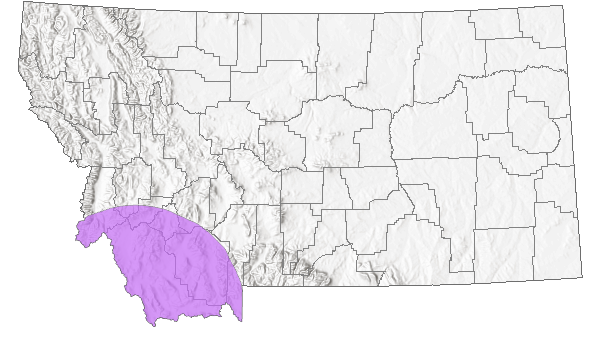
 Native
Native
Range Comments
WA to CA, east to sothwestern MT and AZ. Peripheral.
Observations in Montana Natural Heritage Program Database
Number of Observations: 57
(Click on the following maps and charts to see full sized version)
Map Help and Descriptions
Relative Density

Recency
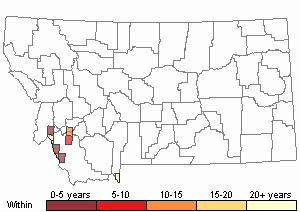
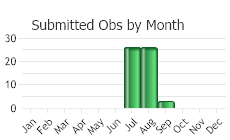
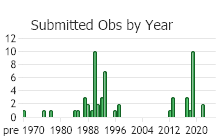
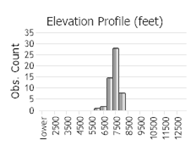 (Observations spanning multiple months or years are excluded from time charts)
(Observations spanning multiple months or years are excluded from time charts)
Habitat
Fens, bog-like areas and wet meadows often dominated by Sphagnum moss in the montane and subalpine zones.
Ecological Systems Associated with this Species
Ecology
POLLINATORS The following animal species have been reported as pollinators of this plant species or its genus where their geographic ranges overlap:
Bombus vagans,
Bombus bifarius,
Bombus centralis,
Bombus flavifrons, and
Bombus pensylvanicus (Thorp et al. 1983, Colla and Dumesh 2010).
Threats or Limiting Factors
STATE THREAT SCORE REASON
Reported threats to Montana's populations of Primrose Monkeyflower include risks from recreational activity and a potential risk of recreational facility development (MTNHP Threat Assessment 2021). Populations found in wetland habitat next to a ski area parking lot are likely impacted by concentrated activity. The potential for this facility to expand poses a continual risk.
References
- Literature Cited AboveLegend:
 View Online Publication
View Online Publication Colla, S.R. and S. Dumesh. 2010. The bumble bees of southern Ontario: notes on natural history and distribution. Journal of the Entomological Society of Ontario 141:39-68.
Colla, S.R. and S. Dumesh. 2010. The bumble bees of southern Ontario: notes on natural history and distribution. Journal of the Entomological Society of Ontario 141:39-68. Thorp, R.W., D.S. Horning, and L.L. Dunning. 1983. Bumble bees and cuckoo bumble bees of California (Hymenoptera: Apidae). Bulletin of the California Insect Survey 23:1-79.
Thorp, R.W., D.S. Horning, and L.L. Dunning. 1983. Bumble bees and cuckoo bumble bees of California (Hymenoptera: Apidae). Bulletin of the California Insect Survey 23:1-79.
- Additional ReferencesLegend:
 View Online Publication
View Online Publication
Do you know of a citation we're missing? Douglas, D.A. 1981. The balance between vegetative and sexual reproduction of Mimulus primuloides (Scrophulariaceae) at different altitudes in California. Journal of Ecology 69:295-310.
Douglas, D.A. 1981. The balance between vegetative and sexual reproduction of Mimulus primuloides (Scrophulariaceae) at different altitudes in California. Journal of Ecology 69:295-310. Lesica, P., M.T. Lavin, and P.F. Stickney. 2012. Manual of Montana Vascular Plants. Fort Worth, TX: BRIT Press. viii + 771 p.
Lesica, P., M.T. Lavin, and P.F. Stickney. 2012. Manual of Montana Vascular Plants. Fort Worth, TX: BRIT Press. viii + 771 p. Lesica, P., M.T. Lavin, and P.F. Stickney. 2022. Manual of Montana Vascular Plants, Second Edition. Fort Worth, TX: BRIT Press. viii + 779 p.
Lesica, P., M.T. Lavin, and P.F. Stickney. 2022. Manual of Montana Vascular Plants, Second Edition. Fort Worth, TX: BRIT Press. viii + 779 p. Schassberger, L.A. 1991. Rare plant inventory of the East Pioneer Mountains. Prepared for the USDA Forest Service, Region 1, Beaverhead National Forest. Montana Natural Heritage Program, Helena, MT. 55 pp.
Schassberger, L.A. 1991. Rare plant inventory of the East Pioneer Mountains. Prepared for the USDA Forest Service, Region 1, Beaverhead National Forest. Montana Natural Heritage Program, Helena, MT. 55 pp.
- Web Search Engines for Articles on "Primrose Monkeyflower"





